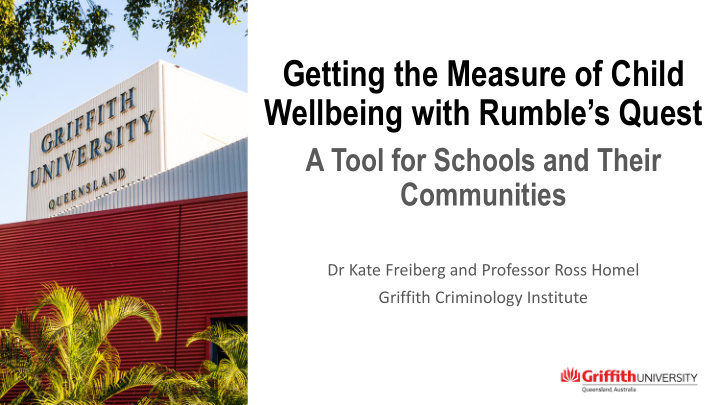



Getting the Measure of Child Wellbeing with Rumble’s Quest A Tool for Schools and Their Communities Dr Kate Freiberg and Professor Ross Homel Griffith Criminology Institute
DATE PRESENTATION TOPIC June 17 th The power of a critical friend - Collective Change Facilitation CREATE 2020 1st July Coalition Wellbeing Survey – The value of measuring the wellbeing of WEBINAR community partnerships SERIES 22 nd July Getting the measure of child with Rumble's Quest: A tool for schools and communities 29 th July The power of wellbeing data for community coalition: Deciding Together risk and protective factor methodology 19th August The capabilities and uses of Parent's Voice - incorporating PEEM, the Parent Empowerment and Efficacy Measure 9th September TBC Demonstration of the power and use of the new Economic Support and Reporting Tool (ESRT) 30th September TBC Strengthening Family-School-Community Relationships – An online Professional Learning Program designed to strengthen Principal’s leadership in forging school-family-community connections to improve student wellbeing and learning outcomes
Tod oday’s O s Outl tline • CREATE project background • Development of Rumble’s Quest Child Wellbeing Measure • System Demonstration • Q & A
The CREATE Project ( Create-ing Pathways to child The he CRE CREATE TE wellbeing in disadvantaged communities ) aims to build prevention science methods and measures WITHIN the routine practices of large scale community service and Pro roject school systems in two states of Australia, Queensland and New South Wales. The focus is the wellbeing of children aged 0-12 years, particularly primary school-aged children 6-12 years . CREATE uses a population health methodology similar to Communities That Care – including the development of community-level child risk and protective factor profiles . This new methodology is the focus of the presentation on July 29
Make good prevention delivery systems better by constructing and testing a Our goal: Prevention Translation and Support System work WITHIN existing delivery Do this for systems Communities for Children (CfC) regions in Australia Australian State Education Departments NGO community services
1. Systems and processes established by Collective Impact Facilitators for: implementing the CREATE community prevention model achieving the core conditions of collective impact Two major 2. An interactive web-based set of electronic resources : components of the Tools for CfC community coalition members to strengthen Griffith Prevention their collective capacity to undertake key activities Translation & fundamental to each stage of the CREATE Change Engine Support System data collection tools for collaborative goal setting and tracking collective outcomes and progress (coalition function, child and family outcomes including Rumble’s Quest, and economic analysis)
The CREATE model
The CREATE Change Cycle
CREATE P E Proj oject Goal oal DEVELOP SUPPORT SYSTEM • Including resources for measuring child wellbeing
As Asse sess ss t to Ad o Address ss • Practical child wellbeing assessment tool to • facilitate systematic collection of data across the community to • guide action strategies tailored to community
https://www.rea ealwel ell.org.au
Criteria
Game technology promotes engagement
RUMBLE’S QUEST DEVELOPMENT TIMELINE Before CREATE Project During CREATE Project 2007-2013 2014-2015 2016 - 2017 2018 - 2020 • • • • Need established Software Ongoing Available for use • Review research literature development: implementation by schools in • Develop Conceptual Framework - Re-program game studies CfC regions (and • • Develop Survey Questions design = RUMBLE’S Factor structure beyond) • • Establish criteria for practical QUEST confirmed Online licence • resource - Management Norming acquisition • Decision to develop as computer Dashboard sample game - User Guides (n >10,000) • Software development: PROTOTYPE - Support resources Game = Clowning Around - Coding for • Psychometric research studies Automated Report - Validity and Reliability Generation established - Factor structure established • Use in 2007-2012 as Pathways to Prevention Project outcomes evaluation tool (proof of concept).
Rumble’ e’s Q Quest Wellbeing ng Scores 57 items Total Score: General wellbeing dimension + Four Subscales: • Attachment to school • Self-regulation • Social confidence • Supportive relationships
EXECUT UTIVE VE F FUNCTION INDICA CATOR S R SCORE RES • Working Memory • Inhibitory Control • Cognitive Flexibility • Attention Control • Focused Attention 19
Go to website rumbles.realwell.org.au/auth/login
Q & A www.realwell.org.au
Recommend
More recommend